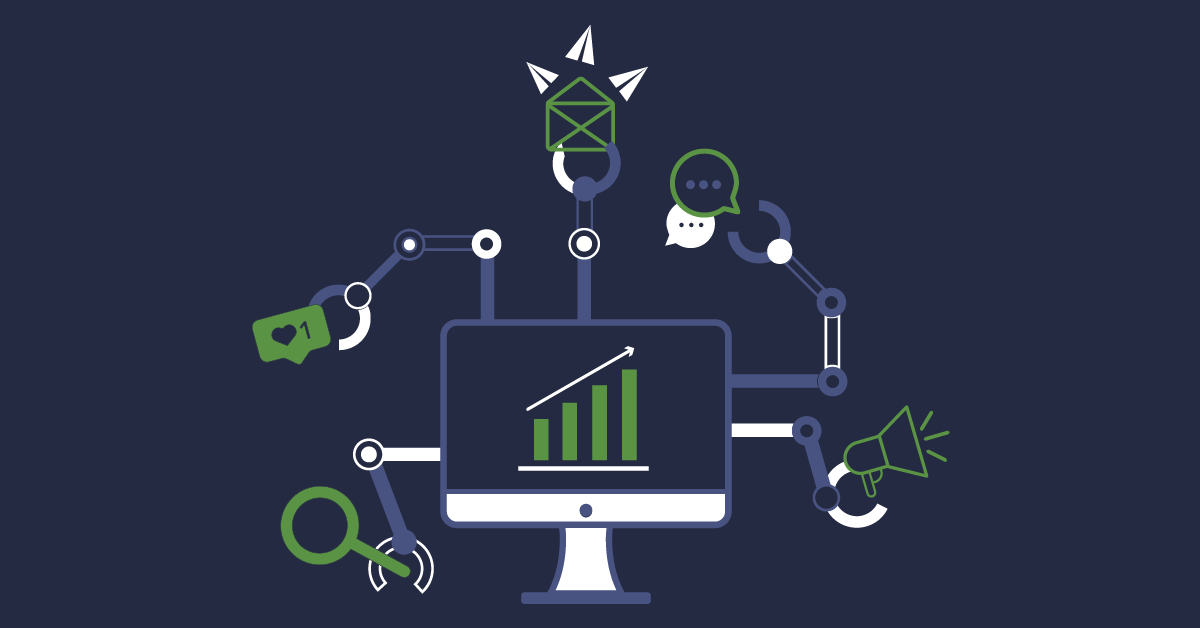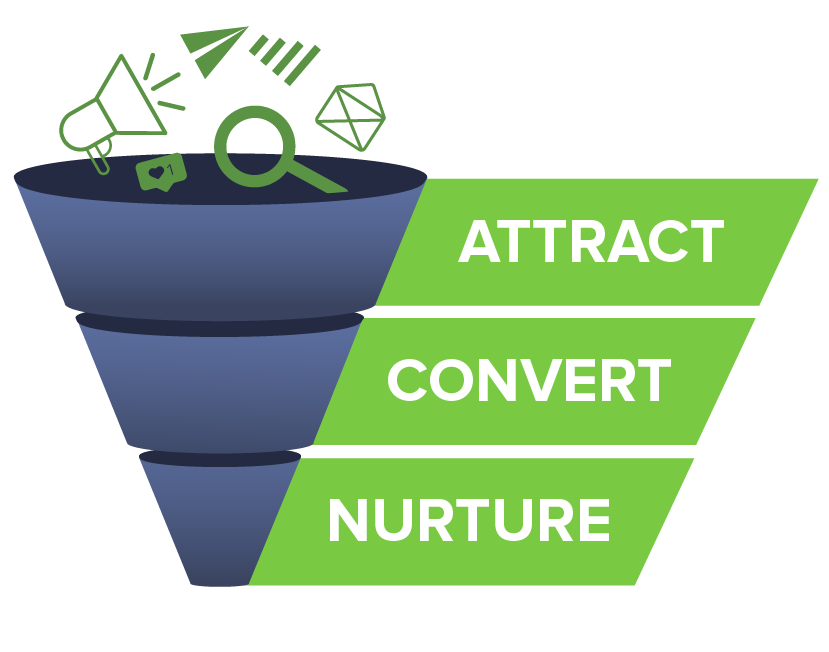
Lúgh Studio’s Ultimate Guide to Lead Generation
04/30/21
digital design
Lead generation is one of the most important things to master as a business owner. It’s the fundamental first step of bringing in new business, and essential to building an audience that repeatedly buys from you. In today’s ultimate guide to lead generation, we cover everything you need to know to master the process.
- What is Lead Generation?
- Why is Lead Generation Important?
- Most Important Principles of Lead Generation
- Visualizing Lead Generation in a Funnel
- Different Strategies for Generating Leads
- Important Metrics for Lead Generation
- Conclusion
What is Lead Generation?
The first step to mastering the process is understanding exactly what it is. It’s likely that you know the basics, but if you want to be successful at lead generation, it should be approached in a specific way.
Lead generation is the process of turning strangers who don’t know anything about you or your business into raving fans. This definition of lead generation includes, of course, the process that has to happen for that transformation to take place.
While lead generation can technically encompass anything that brings in leads, we will be focusing on digital lead generation. After all, over 85% of customers will do online research before approaching your business.
This doesn’t mean that offline efforts to generate leads are a waste of time. In fact, in certain industries, this is still the dominant form of bringing in new prospects. That said, the majority of your efforts should still focus on digital. It’s faster, cheaper, and often much more efficient.
Why is Lead Generation Important?
The only way you can stay profitable as a business is if you have customers. And the only way to do that is to have a consistent source of leads.
Let’s face it: only 15% of your profits will come from recurring customers. This means that you can only hope to consistently make profits if you bring in new people willing to buy from you.
You aren’t profitable if you aren’t generating leads. Simple as that.

Lead generation is also essential because competition has never been higher. You likely have hundreds (if not thousands) of competing companies that offer relatively the same products and services as your own.
This means that you can’t simply rely on people to find you. Rather, generation of new leads is something that should be a weekly (if not daily) priority of yours. Combined with the easy access to information that the internet provides, this competitive environment means that the consumer of 2021 has never been more powerful.
It’s no longer enough to make a product, put your advertisement in front of somebody’s eyes, and get them to buy. Instead, you need to play an active part in bringing in new customers.
And that’s where lead generation comes in.
Most Important Principles of Lead Generation
Let’s move onto principles that you need to have if you hope to succeed. Get these wrong, and no amount of strategy can help you.
1) Digital lead generation is where you should be spending your time and energy. While we already covered this, it bears repeating.
2) In addition to profit, lead generation is your chance to build a relationship with your audience. You have a thousand competitors your audience can go to, so show your potential leads your value above all else. This is the name of the game when it comes to marketing in the age of abundance. Approach lead generation with this mindset and you will naturally attract more leads through trust and value. Check out our ultimate guide to content marketing for more information on this approach.
3) Lead generation is a long-term game, not a short-term. Most people will take quite a while between becoming a lead and becoming a customer. In addition, the average purchasing cycle can be different depending on which industry your lead is in. That’s why you need to commit time to the process.
4) Audience research is essential throughout your marketing for truly effective lead generation. This is one of the most important things you need to get right. It helps you write your copy, make effective lead magnets, and create products that your leads are actually interested in. While talking to your customers is always the way to go, online forums can also be a wealth of valuable information.
5) Always give them an easy way to become a lead. You need to reduce as much friction as possible when it comes to lead generation. While we talk about this in the next section, making things easy is especially important with lead magnets. The longer it takes to become a lead, the less likely somebody is to become one!
6) Different leads have different levels of value. While lead generation is all about bringing people from cold to warm, it’s important to remember that they’re not all the same. The willingness to buy will vary greatly among your leads. You don’t want to generate leads just for the sake of having more of them. Instead, go for the ones that are most likely to convert. This is cheaper and much more efficient.
Visualizing Lead Generation in a Funnel
If you want to excel at lead generation, it’s useful to look at the whole process through a funnel.
While there are various ways to visualize it across a funnel, we will simplify things: attraction, conversion, and nurture. This, at its most basic, is what lead generation is. You attract people to your website or landing page, give them value so they convert into a lead, and then nurture this lead through further value until they become a paying customer.
For effective lead generation, you need to spend time and effort on all three stages.

Let’s look at these three stages in more detail:
Attraction
Attraction is where the lead generation process starts.
This is the process of getting people to your website (although I will also cover paid lead generation, which doesn’t strictly require a website).
You first need to make sure that your website is fast and mobile friendly. If you fail here, people will not stick around on your website long enough to become a lead.
On top of that, your website should be clean, simple, and relatively easy to navigate.
Perhaps the most important thing is WHY you attract new website visitors. What kind of value are you offering? Great blog content? Informative videos?
Whatever the reason, a great website that somehow offers value will attract visitors and prepare them for the next stage of lead generation.
Conversion
Conversion is what people typically equate with lead generation.
This is the stage where you actually turn a site visitor into a lead, typically by collecting their email address.
The name of the game is giving people something so good for free, that they find value in becoming a lead and getting marketed to. Starting with value immediately also sets the expectation that you will be a valuable company to hear from. This increases the average lead value, as well.
It’s how you position yourself to your new prospect as somebody that can solve their problems, and how you convince them to give you their contact information.
In addition, effective lead conversion is a fundamental tenet of “permission marketing,” or getting permission from your lead to market to them.
It’s not enough to generate leads if you never make any money from them.
This is where lead nurturing comes in, where you take leads and turn them into actual customers. Lead nurturing is so important because it is the last step of the lead generation process. It treats the time and attention of leads with respect, and continues to give them value as long as they are on your email list.
That said, a responsive email list is far more important than a big email list. Keep this in mind while going about your email marketing.
Here is the main lesson to remember: lead nurturing doesn’t mean anything if you aren’t actually converting them.
Different Strategies for Generating Leads
Let’s move onto how you actually do lead generation.
There are many different strategies for consistently generating leads. But before you get started implementing any of them, remember this: focus can work wonders. Picking one strategy and getting good at it will be much better for your lead generation success than half-heartedly attempting them all.

This isn’t to say that you can’t diversify your efforts. In fact, your long-term success requires that you do! But when just starting out, it’s much more important to go deep with one or two strategies than to spread yourself too thin.
That said, let’s move onto three general categories of lead generation strategies as well as important information for each one.
Creating useful content is one of the best ways to build up your website traffic. It generates interest in your company and, when optimized for SEO, accelerates your growth over time. Good content also provides a ton of value to your audience and makes it more likely that they subscribe to your email list.
Like I said at the beginning, audience research is essential here. This will give you insight into the problems your audience has and guide the topics you cover in your content strategy.
Once you are creating great content, converting somebody to a lead is usually done through lead magnets attached to signup forms. This is most effectively done through emotionally-convincing copywriting that convinces people to take action.
People want something for free before they are willing to be marketed to. Understandable, right? Check out this guide for everything you need to know about using lead magnets.
Content aimed at lead generation also needs to be promoted. After all, if content is the most reliable way to generate leads, it’s essential that you get as many “eyes” on it as possible.
Check out this guide for more specific tips.
No surprise here, right?
With the rise of social media platforms has come a whole new way to generate leads.
Of course, you need to understand your audience before you can accurately judge which platform would be best for you. Once again, that’s where audience research comes in!
While platforms like Facebook and Instagram have specific practices you should keep in mind, principles of lead generation remain the same.
3) Paid advertising
Our third and final strategy comes with a word of warning: Paid advertising can be effective, but it requires you to constantly pay in order to get results. That means you really need to have the budget for it if it’s going to become a lead generation strategy that works.
That said, with paid advertising, you can drive accelerated results for things that are already working For example, you might drive more traffic to a well-performing piece of content that is optimized to convert leads.
The major benefit here is that paid advertising is much faster than content marketing for lead generation. You have a much more immediate “feedback loop” of what is working and what isn’t, and can adjust accordingly.
The two major platforms for paid advertising are Facebook and Google. Facebook is usually better for B2C businesses, while Google is better for B2B businesses.
Important Metrics for Lead Generation
The last thing you need to become an expert in is your metrics.
After all, lead generation doesn’t mean anything if you can’t measure it!

We’ll keep this section short with the most important metrics.
Website traffic: To generate leads, you need traffic.
Traffic to leads rate: Your traffic only means something if you can turn them into leads.
Leads to customers rate: This is where your profit will come.
Average lead value: This gives you an idea of how many you leads you need to hit your money goals.
Lead score: A more advanced way of seeing which of your leads are the most valuable.
Learn how to track these metrics and you are well on your way to success.
Conclusion
Lead generation is essential for any business
It’s the gift that keeps on giving, because if you are doing it right you are constantly filling your pipeline with potential new customers.
Good luck!









